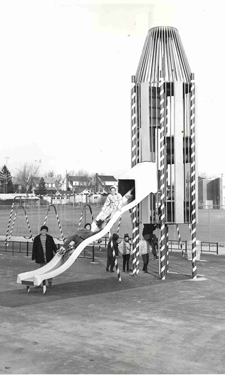 It’s easy to observe the past and acknowledge what could have been different — hindsight is, as the saying goes, 20/20. However, it’s also important to remember that what may seem simple to us now was considered revolutionary back then. Take, for example, this 1960s space-age playground in Philadelphia, Pennsylvania. Decades ago, playgrounds were inspiring young children to use their imaginations and create their own worlds through play. It’s the same today, despite the added and important safety regulations and our evolving attitudes toward children’s play.
It’s easy to observe the past and acknowledge what could have been different — hindsight is, as the saying goes, 20/20. However, it’s also important to remember that what may seem simple to us now was considered revolutionary back then. Take, for example, this 1960s space-age playground in Philadelphia, Pennsylvania. Decades ago, playgrounds were inspiring young children to use their imaginations and create their own worlds through play. It’s the same today, despite the added and important safety regulations and our evolving attitudes toward children’s play.
With designs that are still considered impressive today, vintage space-age playgrounds like this helped shape and promote play for children at a time when space travel was the ultimate innovation and source of wonder. Back then, outdoor play was simply something kids did. Now, we better understand its real benefits and must actively encourage it in order to combat childhood obesity brought on, in part, by the prevalence of technology. Today’s kids are more often plugged in than not.
Fifty years ago, when this playground was built, few worried that children were suffering from a lack of playtime or time spent on outdoor activity. Now, it has become a legitimate concern. However, with a national call to action via First Lady Michelle Obama’s Let’s Move! program, supported through NRPA’s Commit to Health initiatives, the idea of creating challenging and safe, new ways for kids to play and be active is experiencing an important revival. Perhaps it’s the past we should be looking to for inspiration — something from a simpler time to shake up the digital age our children currently inhabit.
Marissa Bracamonte is an Editorial Intern for Parks & Recreation magazine.

